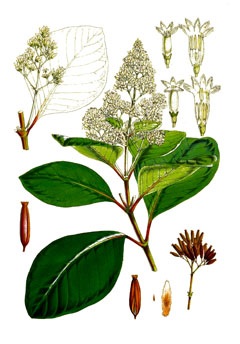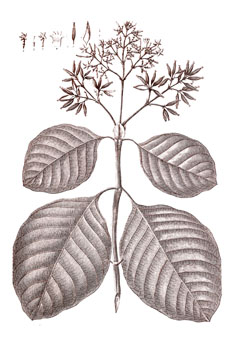 |
|
https://edibleplants.org/ |
 |
| https://edibleplants.org/ |
Translate this page:
Summary
Huannco, Cinchona micrantha, is a small evergreen shrub or tree found in western South America particularly in Bolivia, Ecuador, and Peru. It grows up to 8 m tall. It is used in the treatment of fever, malaria, neuralgia, muscle cramps and sore throats, cardiac fibrillation. The bark is made into tablets, liquid extracts, tinctures and powders. If consumed in high amount, however, it may result to headache, giddiness and deafness.
Physical Characteristics

 Cinchona micrantha is an evergreen Tree growing to 8 m (26ft) by 8 m (26ft) at a medium rate.
Cinchona micrantha is an evergreen Tree growing to 8 m (26ft) by 8 m (26ft) at a medium rate.
See above for USDA hardiness. It is hardy to UK zone 10.
Suitable for: light (sandy) and medium (loamy) soils and prefers well-drained soil. Suitable pH: mildly acid, neutral and basic (mildly alkaline) soils. It can grow in semi-shade (light woodland) or no shade. It prefers moist soil.
UK Hardiness Map
US Hardiness Map
Synonyms
Cinchona affinis Wedd.
Plant Habitats
Edible Uses
Edible Parts: Inner bark
Edible Uses: Drink
Quinine, extracted from the bark of the tree, is used as a bitter flavouring in tonic water and carbonated drinks[ 238 ].
References More on Edible Uses
Medicinal Uses
Plants For A Future can not take any responsibility for any adverse effects from the use of plants. Always seek advice from a professional before using a plant medicinally.
Astringent Cardiac Febrifuge Malaria Tonic
Huannco has a long history of native use, especially as a treatment for fevers and malaria. Modern research has shown it to be a very effective treatment for fevers, and especially as a treatment and preventative of malaria. The bark contains various alkaloids, particularly quinine and quinidine[ 238 ] The bark is a bitter, astringent, tonic herb that lowers fevers, relaxes spasms, is antimalarial (the alkaloid quinine) and slows the heart (the alkaloid quinidine)[ 238 ]. The bark is made into various preparations, such as tablets, liquid extracts, tinctures and powders[ 238 ]. It is used internally in the treatment of malaria, neuralgia, muscle cramps and cardiac fibrillation[ 238 ]. It is an ingredient in various proprietary cold and influenza remedies[ 238 ]. It is also used as a gargle to treat sore throats[ 238 ]. Large and too constant doses must be avoided, as they produce headache, giddiness and deafness[ 418 ].
References More on Medicinal Uses
The Bookshop: Edible Plant Books
Our Latest books on Perennial Plants For Food Forests and Permaculture Gardens in paperback or digital formats.

Edible Tropical Plants
Food Forest Plants for Hotter Conditions: 250+ Plants For Tropical Food Forests & Permaculture Gardens.
More

Edible Temperate Plants
Plants for Your Food Forest: 500 Plants for Temperate Food Forests & Permaculture Gardens.
More

More Books
PFAF have eight books available in paperback and digital formats. Browse the shop for more information.
Shop Now
Other Uses
Teeth
Other uses rating: Low (2/5). The powdered bark is often used in tooth-powders, owing to its astringency[ 418 ].
Special Uses
References More on Other Uses
Cultivation details
Prefers high humidity and a temperature that does not fall below about 15°c[ 238 ]. Requires a well-drained, moist soil and a position in full sun or partial shade[ 238 ].
References Carbon Farming Information and Carbon Sequestration Information
Temperature Converter
Type a value in the Celsius field to convert the value to Fahrenheit:
Fahrenheit:
The PFAF Bookshop
Plants For A Future have a number of books available in paperback and digital form. Book titles include Edible Plants, Edible Perennials, Edible Trees,Edible Shrubs, Woodland Gardening, and Temperate Food Forest Plants. Our new book is Food Forest Plants For Hotter Conditions (Tropical and Sub-Tropical).
Shop Now
Plant Propagation
Seed - Nodal softwood cuttings[ 200 ]. Cuttings of half-ripe wood in a sandy soil[ 200 ].
Other Names
If available other names are mentioned here
Huannco, Cinchona micrantha.
Native Range
SOUTHERN AMERICA: Peru
Weed Potential
Right plant wrong place. We are currently updating this section.
Please note that a plant may be invasive in one area but may not in your area so it's worth checking.
None Known
Conservation Status
IUCN Red List of Threatened Plants Status : This taxon has not yet been assessed

Growth: S = slow M = medium F = fast. Soil: L = light (sandy) M = medium H = heavy (clay). pH: A = acid N = neutral B = basic (alkaline). Shade: F = full shade S = semi-shade N = no shade. Moisture: D = dry M = Moist We = wet Wa = water.
Now available:
Food Forest Plants for Mediterranean Conditions
350+ Perennial Plants For Mediterranean and Drier Food Forests and Permaculture Gardens.
[Paperback and eBook]
This is the third in Plants For A Future's series of plant guides for food forests tailored to
specific climate zones. Following volumes on temperate and tropical ecosystems, this book focuses
on species suited to Mediterranean conditions—regions with hot, dry summers and cool, wet winters,
often facing the added challenge of climate change.
Read More
Expert comment
Author
Ruiz & Pav.
Botanical References
Links / References
For a list of references used on this page please go here
A special thanks to Ken Fern for some of the information used on this page.
Readers comment
| Add a comment |
|
If you have important information about this plant that may help other users please add a comment or link below. Only comments or links that are felt to be directly relevant to a plant will be included. If you think a comment/link or information contained on this page is inaccurate or misleading we would welcome your feedback at [email protected]. If you have questions about a plant please use the Forum on this website as we do not have the resources to answer questions ourselves.
* Please note: the comments by website users are not necessarily those held by PFAF and may give misleading or inaccurate information.
To leave a comment please Register or login here All comments need to be approved so will not appear immediately.
|
Subject : Cinchona micrantha
|
|
|
|